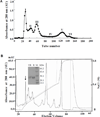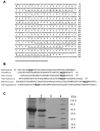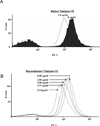A novel family of RGD-containing disintegrins (Tablysin-15) from the salivary gland of the horsefly Tabanus yao targets αIIbβ3 or αVβ3 and inhibits platelet aggregation and angiogenesis
- PMID: 21475772
- PMCID: PMC3499621
- DOI: 10.1160/TH11-01-0029
A novel family of RGD-containing disintegrins (Tablysin-15) from the salivary gland of the horsefly Tabanus yao targets αIIbβ3 or αVβ3 and inhibits platelet aggregation and angiogenesis
Abstract
A novel family of RGD-containing molecules (Tablysin-15) has been molecularly characterised from the salivary gland of the haematophagous horsefly Tabanus yao. Tablysin-15 does not share primary sequence homology to any disintegrin discovered so far, and displays an RGD motif in the N-terminus of the molecule. It is also distinct from disintegrins from Viperidae since its mature form is not released from a metalloproteinase precursor. Tablysin-15 exhibits high affinity binding for platelet αIIbβ3 and endothelial cell αVβ3 integrins, but not for α5β1 or α2β1. Accordingly, it blocks endothelial cell adhesion to vitronectin (IC50 ~1 nM) and marginally to fibronectin (IC50 ~1 μM), but not to collagen. It also inhibits fibroblast growth factor (FGF)-induced endothelial cell proliferation, and attenuates tube formation in vitro. In platelets, Tablysin-15 inhibits aggregation induced by collagen, ADP and convulxin, and prevents static platelet adhesion to immobilised fibrinogen. In addition, solid-phase assays and flow cytometry demonstrates that αIIbβ3 binds to Tablysin-15. Moreover, immobilised Tablysin-15 supports platelet adhesion by a mechanism which was blocked by anti-integrin αIIbβ3 monoclonal antibody (e.g. abciximab) or by EDTA. Furthermore, Tablysin-15 dose-dependently attenuates thrombus formation to collagen under flow. Consistent with these findings, Tablysin-15 displays antithrombotic properties in vivo suggesting that it is a useful tool to block αIIbβ3, or as a prototype to develop antithrombotics. The RGD motif in the unique sequence of Tablysin-15 represents a novel template for studying the structure-function relationship of the disintegrin family of inhibitors.
Conflict of interest statement
Conflict-of-interest disclosure: The authors have no conflicting financial interests.
Figures







Similar articles
-
Disintegrins from hematophagous sources.Toxins (Basel). 2012 May;4(5):296-322. doi: 10.3390/toxins4050296. Epub 2012 Apr 26. Toxins (Basel). 2012. PMID: 22778902 Free PMC article. Review.
-
Modulation of RGD sequence motifs regulates disintegrin recognition of alphaIIb beta3 and alpha5 beta1 integrin complexes. Replacement of elegantin alanine-50 with proline, N-terminal to the RGD sequence, diminishes recognition of the alpha5 beta1 complex with restoration induced by Mn2+ cation.Biochem J. 1998 Oct 15;335 ( Pt 2)(Pt 2):247-57. doi: 10.1042/bj3350247. Biochem J. 1998. PMID: 9761721 Free PMC article.
-
Disintegrin Tablysin-15 Suppresses Cancer Hallmarks in Melanoma Cells by Blocking FAK/Akt/ERK and NF-κB Signaling.Curr Cancer Drug Targets. 2020;20(4):306-315. doi: 10.2174/1568009620666200101094736. Curr Cancer Drug Targets. 2020. PMID: 31893992
-
Accutin, a new disintegrin, inhibits angiogenesis in vitro and in vivo by acting as integrin alphavbeta3 antagonist and inducing apoptosis.Blood. 1998 Nov 1;92(9):3268-76. Blood. 1998. PMID: 9787163
-
[Disintegrins: potent inhibitors of platelet aggregation].Recenti Prog Med. 1995 Apr;86(4):168-74. Recenti Prog Med. 1995. PMID: 7617961 Review. Italian.
Cited by
-
A minireview of the medicinal and edible insects from the traditional Chinese medicine (TCM).Front Pharmacol. 2023 Mar 16;14:1125600. doi: 10.3389/fphar.2023.1125600. eCollection 2023. Front Pharmacol. 2023. PMID: 37007003 Free PMC article. Review.
-
Triplatin, a platelet aggregation inhibitor from the salivary gland of the triatomine vector of Chagas disease, binds to TXA(2) but does not interact with glycoprotein PVI.Thromb Haemost. 2012 Jan;107(1):111-23. doi: 10.1160/TH11-10-0685. Epub 2011 Dec 8. Thromb Haemost. 2012. PMID: 22159626 Free PMC article.
-
Disintegrins from hematophagous sources.Toxins (Basel). 2012 May;4(5):296-322. doi: 10.3390/toxins4050296. Epub 2012 Apr 26. Toxins (Basel). 2012. PMID: 22778902 Free PMC article. Review.
-
Heligmosomoides polygyrus Venom Allergen-like Protein-4 (HpVAL-4) is a sterol binding protein.Int J Parasitol. 2018 Apr;48(5):359-369. doi: 10.1016/j.ijpara.2018.01.002. Epub 2018 Mar 2. Int J Parasitol. 2018. PMID: 29505764 Free PMC article.
-
The "Vampirome": Transcriptome and proteome analysis of the principal and accessory submaxillary glands of the vampire bat Desmodus rotundus, a vector of human rabies.J Proteomics. 2013 Apr 26;82:288-319. doi: 10.1016/j.jprot.2013.01.009. Epub 2013 Feb 11. J Proteomics. 2013. PMID: 23411029 Free PMC article.
References
-
- Hood JD, Cheresh DA. Role of integrins in cell invasion and migration. Nat Rev Cancer. 2002 Feb;2(2):91–100. - PubMed
-
- Zannetti A, Del Vecchio S, Iommelli F, et al. Imaging of alpha(v)beta(3) expression by a bifunctional chimeric RGD peptide not cross-reacting with alpha(v)beta(5) Clin Cancer Res. 2009 Aug 15;15(16):5224–5233. - PubMed
-
- Markland FS. Snake venoms and the hemostatic system. Toxicon. 1998 Dec;36(12):1749–1800. - PubMed
Publication types
MeSH terms
Substances
Grants and funding
LinkOut - more resources
Full Text Sources
Other Literature Sources

